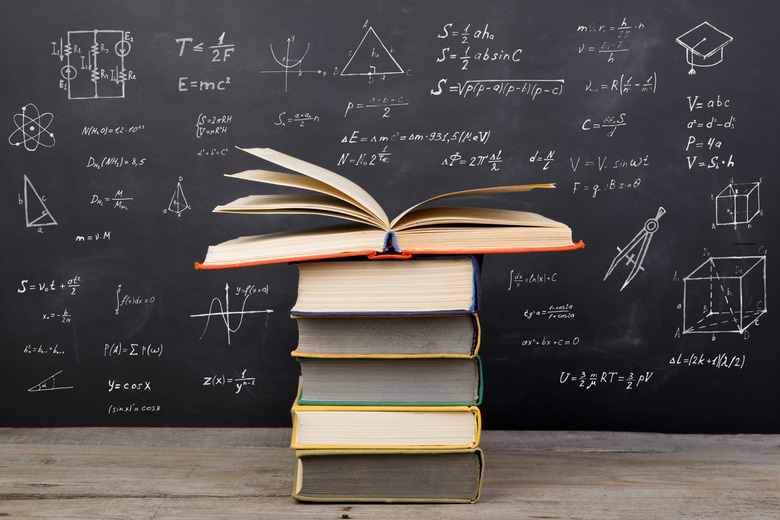What Is A Precipitation Reaction?
A precipitation reaction takes place when two different materials react in a solution to form an insoluble product. The insoluble product of the reaction forms a powder, solid mass or crystal that either sink to the bottom of the liquid solution or stay in suspension. The solution may contain the remaining chemicals that did not react, or it may contain another reaction product that is soluble and remains in solution. Many chemical experiments involving precipitation reactions are easy to carry out and produce interesting results, often with colorful precipitates.
TL;DR (Too Long; Didn't Read)
A precipitation reaction produces an insoluble solid as a result of the reaction of two dissolved chemicals in a solution. The insoluble solid, called a precipitate, sinks to the bottom of the solution or stays in suspension as cloudy particles. The parts of the dissolved chemicals that did not take part in the precipitation reaction remain in solution after the precipitate forms. The precipitation process can be used to remove an impurity from water or in the production of industrial chemicals.
Ionic Compounds in Solution
Ionic Compounds in Solution
Precipitation reactions can only take place when two conditions are fulfilled. The dissolved compounds have to dissociate into ions, and the ions have to be able to combine to form a new compound. As a result, only ionic compounds in solution can produce a precipitate.
Ionic compounds are formed when atoms with only one or two electrons in their outermost shells react with an atoms that need one or two electrons to complete their electron shells. When two such materials react, the former atoms release their electrons and donate them to the latter atoms. This means that all the atoms have achieved the stable configuration of complete outer electron shells. At the same time, the atoms that have received electrons ares now negatively charged while the atoms that have donated electrons have a positive charge. The oppositely charged atoms are attracted to each other and form ionic bonds.
When ionic compounds dissolve in water, the polar water molecules, which have a positive charge at one end and a negative charge at the other, attach themselves to the charged atoms of the ionic compounds and pull them apart. The ions are then free to react with other ions in the solution to form a new compound.
How Precipitation Works
How Precipitation Works
In a precipitation reaction, a solution of one ionic compound is added to the solution of another ionic compound with which it can react. The reaction takes place as the two solutions are mixed and the insoluble precipitate forms. Depending on the reaction, another reaction compound may form and remain in solution or the other reaction product may be water or a gas. The reaction is a precipitate reaction if a solid appears at the bottom of the solution container or the solution turns cloudy with a suspension of precipitate particles.
A typical precipitation reaction occurs when aqueous solutions of potassium iodide and lead nitrate are mixed. The potassium, iodine, lead and nitrate ions dissolve, and the potassium ions react with the nitrate ions to form potassium nitrate while the lead ions react with the iodine ions to form lead iodide. Lead iodide is insoluble in water and precipitates as a bright yellow solid in a double replacement reaction. The potassium nitrate stays in solution.
Another precipitation reaction mixes aqueous solutions of silver nitrate with sodium chloride or common table salt. The ions in solution are silver ions, nitrate ions, sodium ions and chlorine ions. The corresponding equation is AgNO3 + NaCl = AgCl + NaNO3. The Ag ions and the Cl ions form AgCl, which is insoluble in water and precipitates out.
Precipitation reactions happen any time soluble compounds react to create an insoluble product. Precipitates may be a nuisance such as when they clog water pipes or form kidney stones, but these reactions can also be used to get rid of harmful dissolved chemicals or to precipitate valuable minerals from a solution.
Cite This Article
MLA
Markgraf, Bert. "What Is A Precipitation Reaction?" sciencing.com, https://www.sciencing.com/what-is-a-precipitation-reaction-13712166/. 30 April 2018.
APA
Markgraf, Bert. (2018, April 30). What Is A Precipitation Reaction?. sciencing.com. Retrieved from https://www.sciencing.com/what-is-a-precipitation-reaction-13712166/
Chicago
Markgraf, Bert. What Is A Precipitation Reaction? last modified March 24, 2022. https://www.sciencing.com/what-is-a-precipitation-reaction-13712166/
